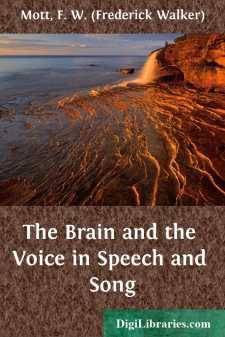Categories
- Antiques & Collectibles 13
- Architecture 36
- Art 48
- Bibles 22
- Biography & Autobiography 813
- Body, Mind & Spirit 142
- Business & Economics 28
- Children's Books 14
- Children's Fiction 11
- Computers 4
- Cooking 94
- Crafts & Hobbies 4
- Drama 346
- Education 46
- Family & Relationships 57
- Fiction 11829
- Games 19
- Gardening 17
- Health & Fitness 34
- History 1377
- House & Home 1
- Humor 147
- Juvenile Fiction 1873
- Juvenile Nonfiction 202
- Language Arts & Disciplines 88
- Law 16
- Literary Collections 686
- Literary Criticism 179
- Mathematics 13
- Medical 41
- Music 40
- Nature 179
- Non-Classifiable 1768
- Performing Arts 7
- Periodicals 1453
- Philosophy 64
- Photography 2
- Poetry 896
- Political Science 203
- Psychology 42
- Reference 154
- Religion 513
- Science 126
- Self-Help 84
- Social Science 81
- Sports & Recreation 34
- Study Aids 3
- Technology & Engineering 59
- Transportation 23
- Travel 463
- True Crime 29
The Brain and the Voice in Speech and Song
Categories:
Description:
Excerpt
THEORIES ON THE ORIGIN OF SPEECH
The evolutionary theory is thus propounded by Romanes in his "Mental Evolution in Man," pp. 377-399: "Starting from the highly intelligent and social species of anthropoid ape as pictured by Darwin, we can imagine that this animal was accustomed to use its voice freely for the expression of the emotions, uttering danger signals, and singing. Possibly it may also have been sufficiently intelligent to use a few imitative sounds; and certainly sooner or later the receptual life of this social animal must have advanced far enough to have become comparable with that of an infant of about two years of age. That is to say, this animal, although not yet having begun to use articulate signs, must have advanced far enough in the conventional use of natural signs (a sign with a natural origin in tone and gesture, whether spontaneously or intentionally imitative) to have admitted of a totally free exchange of receptual ideas, such as would be concerned in animal wants and even, perhaps, in the simplest forms of co-operative action. Next I think it probable that the advance of receptual intelligence which would have been occasioned by this advance in sign-making would in turn have led to a development of the latter—the two thus acting and reacting on each other until the language of tone and gesture became gradually raised to the level of imperfect pantomime, as in children before they begin to use words. At this stage, however, or even before it, I think very probably vowel sounds must have been employed in tone language, if not also a few consonants. Eventually the action and reaction of receptual intelligence and conventional sign-making must have ended in so far developing the former as to have admitted of the breaking up (or articulation) of vocal sounds, as the only direction in which any improvement in vocal sign-making was possible." Romanes continues his sketch by referring to the probability that this important stage in the development of speech was greatly assisted by the already existing habit of articulating musical notes, supposing our progenitors to have resembled the gibbons or the chimpanzees in this respect. Darwin in his great work on the "Expression of the Emotions" points to the fact that the gibbon, the most erect and active of the anthropoid apes, is able to sing an octave in half-tones, and it is interesting to note that Dubois considers his Pithecanthropus Erectus is on the same stem as the gibbon. But it has lately been shown that some animals much lower in the scale than monkeys, namely, rodents, are able to produce correct musical tones. Therefore the argument loses force that the progenitors of man probably uttered musical sounds before they had acquired the power of articulate speech, and that consequently, when the voice is used under any strong emotion, it tends to assume through the principle of association a musical character. The work of anthropologists and linguists, especially the former, supports the progressive-evolution theory, which, briefly stated, is—that articulate language is the result of an elaboration in the long procession of ages in which there occurred three stages—the cry, vocalisation, and articulation....


